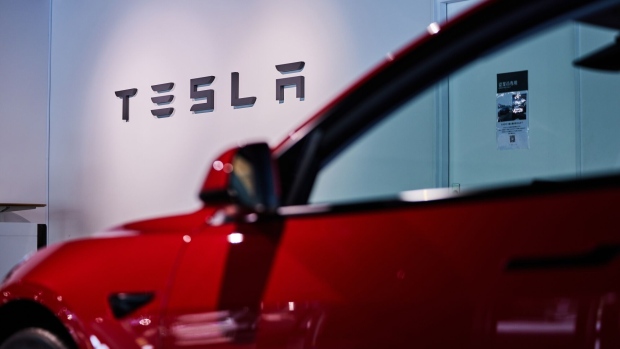Apr 23, 2024
Tesla to Accelerate Launch of Cheaper Cars After Sales Miss
, Bloomberg News

(Bloomberg) -- Tesla Inc. shares surged after Elon Musk vowed to launch less-expensive vehicles as soon as late this year, easing concerns about disappointing earnings results and diminished growth prospects.
The automaker said Tuesday it’s accelerating new models using aspects of a next-generation platform that had been slated for the second half of next year. The new vehicles will be built on the same manufacturing lines as Tesla’s current lineup and be ready by early 2025, if not before year-end, the chief executive officer said.
The change of plans overshadowed falling vehicle sales, worse-than-expected revenue and profit, and the company burning through more than $2.5 billion cash in a single quarter. Musk had spooked investors in the weeks leading up to the report by signaling self-driving vehicles had taken precedence over bringing a $25,000 car to market.
“What matters is investors have some spark of hope that growth will re-accelerate next year,” said Gene Munster, managing partner at Deepwater Asset Management. “For the believers, he gave them enough to continue to stay the course.”
Tesla shares soared 14% shortly after the start of regular trading Wednesday, their biggest intraday jump since October 2021. The stock has been the worst performer in the S&P 500 Index this year, plunging 42% through Tuesday’s close.
Read More: Musk Says Don’t Own Tesla If You Don’t Believe in Autonomy
In a call with analysts, Musk took a dig at carmakers that have pared EV production plans and pivoted to more gas-electric hybrids. While he didn’t refer to any manufacturers by name, General Motors Co. and Ford Motor Co. are among the manufacturers that have made this adjustment in recent months.
“The EV adoption rate globally is under pressure and a lot of other auto manufactures are pulling back on EVs and pursuing plug-in hybrids instead,” he said. “This is not the right strategy.”
Tesla’s own strategy has been muddled of late. It’s spent more than a year slashing prices across the lineup in an effort to boost sales. Instead, growth in vehicle deliveries slowed last year, then gave way to a surprise 8.5% drop in the first quarter, when the company built 46,561 more cars than it sold.
Investors have been unsettled this month by reports that Musk has abandoned a $25,000 model at the expense of his high-risk pursuit of fully autonomous cars. The CEO demurred when asked during the earnings call whether a vehicle at that price point is still planned, saying only that there will be more to share when Tesla shows a dedicated robotaxi in August.
Bloomberg reported earlier this week that a next-generation vehicle project had morphed into an effort to wring cost reductions out of components and production methods, then apply those innovations to cheaper iterations of the Model Y and Model 3, the company’s two most popular EVs.
Musk said Tuesday that the new vehicles Tesla is accelerating “will use aspects of the next-generation platform as well as aspects of our current platforms, and will be able to be produced on the same manufacturing lines as our current vehicle lineup.”
“We are left asking — is this just a refreshed M3/Y?” Chris McNally, an Evercore ISI analyst with the equivalent of a hold rating on Tesla’s stock, wrote in a report, referring to the Model 3 and Model Y.
Read More: Tesla’s Cloudy Pipeline May Spell Danger for US EV Leader
The new plan isn’t contingent on any new factory or production lines and should eventually enable Tesla to get to more than 3 million vehicles of production capacity, Musk said. The company said in its earnings presentation that its current installed capacity is more than 2.35 million.
Tesla will continue work on a new module-based “unboxed” manufacturing process for the dedicated robotaxi Musk teased earlier this month. The CEO referred to it on the call as as the Cybercab.
While Tesla remains the dominant EV maker in the US market, its financial performance has sagged for several quarters. Adjusted earnings per share fell to 45 cents in the first three months of the year, short of Wall Street’s expectation for 52 cents a share. Revenue dropped almost 9% to $21.3 billion, roughly in line with its first year-over-year drop in deliveries since 2020. This also was short of the $22.3 billion analysts were expecting.
Tesla’s vehicle inventory swelled to 28 days, nearly double the 15 days at the end of the last quarter. The metric captures how long it takes for a car company to move vehicles off its lots.
“We expect the inventory build to reverse in the second quarter and free cash flow to return to positive” territory, Chief Financial Officer Vaibhav Taneja told investors on the call.
The Austin-based EV maker kept its near-term growth expectations in check, saying growth in vehicle deliveries may be “notably lower” than last year.
Tesla initiated its biggest-ever round of layoffs last week, announcing plans for a more than 10% cut to headcount. Bloomberg has reported Musk has pushed for a 20% reduction. Two senior executives announced their departures in the midst of the restructuring. Another prominent manager, Tesla’s head of investor relations Martin Viecha, said during Tuesday’s call that he’ll be leaving the company.
--With assistance from Max Chafkin, Subrat Patnaik and Craig Trudell.
(Updates share move in the fifth paragraph. An earlier version corrected the spelling of Tesla in the 16th paragraph.)
©2024 Bloomberg L.P.





